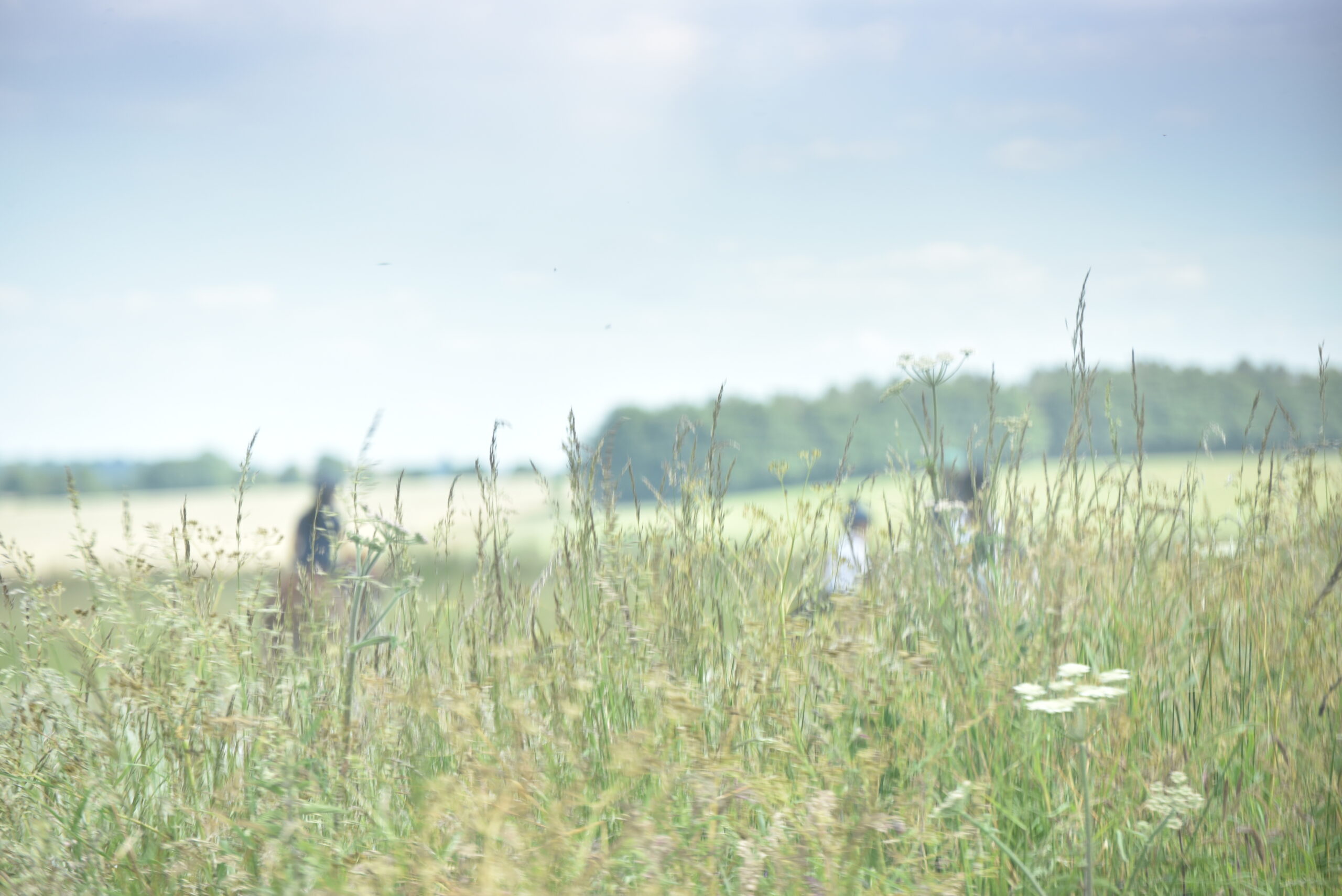Adding diversity to horse pastures can support a balanced diet, be good for digestive health, and possibly reduce health risks such as laminitis. The diversity encourages foraging behaviour in horses, as they can select what to graze on, based on their own needs or preferences. In addition, having a high diversity of grass, tree, hedge, flower and herbs in grasslands and paddocks supports biodiversity and soil health, by stabilising soil root structure, supporting the water cycle and encouraging pollinators, invertebrates and other beneficial microorganisms.
Disclaimer: Below we have provided a list of plant species deemed safe for horses to consume. However, the dietary needs vary for every horse individually and this may not be true for your horse(s). Please ensure you consult a vet, equine nutritionist and other equine professionals to determine what is safe and appropriate for your own horse’s needs before making changes to feeding and grazing.
Horse-safe grasses
- Crested Dogs Tail (Cynosurus cristatus), a grass tolerant of many soil types, palatable for horses and the main food for caterpillars of several brown and skipper family butterfly species.
- Creeping red fescue (Festuca rubra), tolerant to close grazing and fairly heavy footfall, with creeping roots that improve soil structure and
- Meadow fescue (Lolium pratense), tolerant to close grazing and fairly heavy footfall with deep roots that improve soil structure and aid water retention making it drought resilient.
- Chewings fescue (Festuca rubra commutata), tolerant to close grazing and fairly heavy footfall, which wont smother when mixed with other more delicate plant species.
- Sheeps fescue (Festuca ovina), tolerant to close grazing and fairly heavy footfall, this is a hardy, drought resistant species.
- Smooth stalked meadowgrass (Poa pratensis), tolerates close grazing and is highly palatable to horses.
- Timothy (Phleum pratense), very palatable, good for late season grazing, adaptable to ground conditions and a source of food and habitat for many butterfly and invertebrate species.
- Cocksfoot (Dactylis glomerata), resilient to frost, and drought tolerant due to its deep roots. It is a source of pollen and provides habitat for small mammals, insects and bees.
- Browntop bent (Agrostis capillaris), low in sugars and starches, so can be beneficial to horses with EMS or laminitis. Its works well in wildflower seed mixtures as it wont crowd them out.
- Yorkshire fog (Holcus lanatus), can handle infertile soils, acidic soils and wet conditions. This ia food source eaten by small and Essex Skipper caterpillars, and rabbits and horses will eat the seedheads.
Horse safe herbs
- Ribgrass, a rich source of calcium, selenium, high in anti-inflammatory compounds and supports equine digestion.
- Fenugreek, high in nutrients, including protein and fat, and aids equine digestion.
- Sheep’s parsley, high in iron and vitamins A and C. It is useful to alleviate the symptoms of kidney and bladder complaints.
Horse-safe wildflowers
- Sainfoin (Onobrychis viciifolia), has natural worming properties in horses and can aid in the digestion of protein as well as being high in omega-3 fatty acids (immune system boosting).
- Kidney Vetch (Anthyllis vulneraria), a good source of trace minerals
- Lady’s bedstraw (Galium verum) a good source of trace minerals
- Ribwort Plantain (Plantago lanceolata), rich in calcium and selenium and high in anti-inflammatory compounds.
- Meadowsweet (Filipendula ulmaria), acts as a natural ulcer treatment, as well as being good for digestion and joint pain
- Lucerne (also known as Alfalfa) (Medicago sativa), a nutrient-dense legume that contains digestible energy, protein calcium and less sugar and starch than most grasses.
- Sheep’s burnet (or salad burnet) (Sanguisorba minor), a good source of trace elements.
- Dandelion (Taraxacum officinale), high in potassium and acts as a natural diuretic cleansing the liver with the potential to provide natural relief for chronic pain and inflammation.
Horse safe hedges
- Hawthorn (Crataegus monogyna), a good all-round, dense hedge, its berries are sometines used in horse supplements to support circulation.
- Field maple (Acer campestre), is often used in mixed-species hedges and provides good coverage. N.B. some other Maple species are toxic to horses and must be avoided.
- Dog Rose, (Rosa canina), a native British species that attracts wildlife.
- Dog Wood (Cornus sanguinea), a source of horse-safe forage that also supports wildlife, with its fruits and flowers.
- Wild Pear (Pyrus pyraster), in the spring it attracts insects including bees to the blossom and birds and small mammals which eat the fruit in autumn.
- Sweet Briar (Rosa rubiginosa), an attractive flowering species supporting pollinators.
- Hornbeam (Caprinus betulus), an evergreen hedge species providing year-round shelter and forage for horses.
- Hazel (Corylus avellana), a fast-growing native British species which tolerates a range of soil conditions.
- Rowan (Sorbus aucuparia), a hardy, fast-growing and attractive species, with the berries providing food for birds and wildlife
References
https://ker.com/equinews/pros-and-cons-of-turfgrass-for-horse-pastures
https://meadowmania.co.uk/blogs/news/tagged/category-2-horse-paddock-seed
https://www.woodlandtrust.org.uk/trees-woods-and-wildlife/british-trees/a-z-of-british-trees/dogwood
https://www.cotswoldseeds.com/species/59/smooth-stalked-meadow-grass
https://www.wildlifetrusts.org/wildlife-explorer/grasses-sedges-and-rushes/crested-dogs-tail
https://www.woodlandtrust.org.uk/trees-woods-and-wildlife/plants/grasses-and-sedges/cocksfoot-grass
https://www.cotswoldseeds.com/species/51/red-fescue-chewings-fescue
https://www.woodlandtrust.org.uk/trees-woods-and-wildlife/plants/grasses-and-sedges/timothy-grass
Ready to start your journey?
Get in touch today.
Contact us



